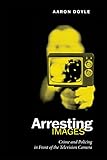Arresting Images : Crime and Policing in Front of the Television Camera / Aaron Doyle.
Material type: TextPublisher: Toronto : University of Toronto Press, [2003]Copyright date: ©2003Description: 1 online resource (192 p.)Content type:
TextPublisher: Toronto : University of Toronto Press, [2003]Copyright date: ©2003Description: 1 online resource (192 p.)Content type: - 9780802085047
- 9781442671003
- 302.23/45
- online - DeGruyter
| Item type | Current library | Call number | URL | Status | Notes | Barcode | |
|---|---|---|---|---|---|---|---|
 eBook
eBook
|
Biblioteca "Angelicum" Pont. Univ. S.Tommaso d'Aquino Nuvola online | online - DeGruyter (Browse shelf(Opens below)) | Online access | Not for loan (Accesso limitato) | Accesso per gli utenti autorizzati / Access for authorized users | (dgr)9781442671003 |
restricted access online access with authorization star
http://purl.org/coar/access_right/c_16ec
While most research on television examines its impact on viewers, Arresting Images asks instead how TV influences what is in front of the camera, and how it reshapes other institutions as it broadcasts their activities. Aaron Doyle develops his argument with four studies of televised crime and policing: the popular American 'reality-TV' series Cops; the televising of surveillance footage and home video of crime and policing; footage of Vancouver's Stanley Cup riot; and the publicity-grabbing demonstrations of the environmental group Greenpeace. Each of these studies is of significant interest in its own right, but Doyle also uses them to make a broader argument rethinking television's impacts. The four studies show how televised activities tend to become more institutionally important, tightly managed, dramatic, simplified and fitted to society's dominant values. Powerful institutions, like the police, harness television for their own legitimation and surveillance purposes, often dictating which situations are televised, and usually producing 'authorized definitions' of the situations, which allow them to control the consequences. While these institutions invoke the notion that "seeing is believing" to reinforce their positions of dominance, the book argues that many observers and researchers have long overstated and misunderstood the role of TV's visual component in shaping its influences.
Mode of access: Internet via World Wide Web.
In English.
Description based on online resource; title from PDF title page (publisher's Web site, viewed 01. Nov 2023)


